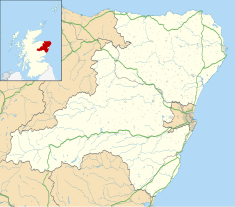New Slains Castle
| New Slains Castle | |
|---|---|

Ruins of New Slains Castle from the south
|
|
| Coordinates | 57°24′55″N 1°49′57″W / 57.4152°N 1.8324°WCoordinates: 57°24′55″N 1°49′57″W / 57.4152°N 1.8324°W |
| OS grid reference | NK 102 361 |
| Built | after 1597 |
| Built for | Francis Hay, 9th Earl of Erroll |
| Rebuilt | 1836–1837 |
| Architect | John Smith |
Slains Castle, also known as New Slains Castle to distinguish it from nearby Old Slains Castle, is a ruined castle in Aberdeenshire, Scotland. It overlooks the North Sea from its cliff-top site 1 kilometre (0.62 mi) east of Cruden Bay. The core of the castle is a 16th-century tower house, built by the 9th Earl of Erroll. Significant reconstruction of the castle has been carried out a number of times, lastly in 1837 when it was rebuilt as a Scots Baronial mansion. At one time it had three extensive gardens, but is now a roofless ruin. Plans to restore the castle have been on hold since 2009.
The Clan Hay were a powerful family in the area for generations, having possessed the lands of Slains since the 14th century. In 1453 Sir William Hay, the clan chief, was made Earl of Erroll by King James II. At this time the local seat of power was Old Slains Castle, near Collieston some 8 kilometres (5.0 mi) to the south-west. Francis Hay, 9th Earl of Erroll, succeeded in 1585, and converted to Roman Catholicism. He conspired with other Catholic nobles, including the Earl of Huntly, with whom he joined in a brief rebellion in 1589. Erroll was also a signatory of the "Spanish Blanks", documents signed by members of the Catholic nobility of Scotland, and otherwise left to be filled in with the terms of Spanish aid. Erroll was declared a traitor in 1594, and Old Slains Castle was destroyed in October on the orders of King James VI.
...
Wikipedia

